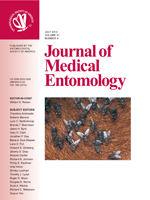We examined temporal changes in the abundance of the mosquitoes Aedes (Stegomyia) aegypti (L.) and Aedes (Ochlerotatus) epactius Dyar & Knab from June to October 2012 in one reference community at lower elevation (Rio Blanco; ≈1,270 m) and three high-elevation communities (Acultzingo, Maltrata, and Puebla City; 1,670–2,150 m) in Veracruz and Puebla States, México. The combination of surveys for pupae in water-filled containers and trapping of adults, using BG-Sentinel traps baited with the BG-Lure, corroborated previous data from 2011 showing that Ae. aegypti is present at low abundance up to 2,150 m in this part of México. Data for Ae. aegypti adults captured through repeated trapping in fixed sites in Acultzingo—the highest elevation community (≈1,670 m) from which the temporal intra-annual abundance pattern for Ae. aegypti has been described—showed a gradual increase from low numbers in June to a peak occurrence in late August, and thereafter declining numbers in September. Ae. epactius adults were collected repeatedly in BG-Sentinel traps in all four study communities; this is the first recorded collection of this species with a trap aiming specifically to collect human-biting mosquitoes. We also present the first description of the temporal abundance pattern for Ae. epactius across an elevation gradient: peak abundance was reached in mid-July in the lowest elevation community (Rio Blanco) but not until mid-September in the highest elevation one (Puebla City). Finally, we present data for meteorological conditions (mean temperature and rainfall) in the examined communities during the study period, and for a cumulative measure of the abundance of adults over the full sampling period.
How to translate text using browser tools
1 July 2014
Intra-Annual Changes in Abundance of Aedes (Stegomyia) aegypti and Aedes (Ochlerotatus) epactius (Diptera: Culicidae) in High-Elevation Communities in México
Saul Lozano-Fuentes,
Carlos Welsh-Rodriguez,
Andrew J. Monaghan,
Daniel F. Steinhoff,
Carolina Ochoa-Martinez,
Berenice Tapia-Santos,
Mary H. Hayden,
Lars Eisen
ACCESS THE FULL ARTICLE
It is not available for individual sale.
This article is only available to subscribers.
It is not available for individual sale.
It is not available for individual sale.

Journal of Medical Entomology
Vol. 51 • No. 4
July 2014
Vol. 51 • No. 4
July 2014
abundance
Aedes aegypti
Aedes epactius
high elevation
temporal change




